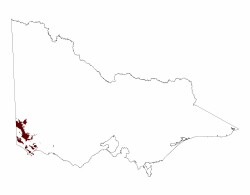6.2.1 Plains with ridges (Follett)
6. Western Plains (WP)
6.2 Sedimentary plains (Plains on unconsolidated (sedimentary) deposits
| Located in the very south-west corner of the Wimmera CMA region is the Kanawinka sand plains and dunes soil-landform unit. More pronounced and quite extensive in the south-west of the Glenelg-Hopkins CMA region, the sand plains and dunes recognise a change from the Low ridge tops with remnant aeolian sands and oriented swales with lakes and lunettes geomorphological division (5.5.2) to this landscape. While the surface expression in terms of topography, soils and vegetation is extremely similar, this geomorphology reflects a transition to later sediments deposited further south-west into Victoria and South Australia. Sand sheets and dunes of this landscape include dunes with crests, slopes and associated plains with little relief (approximately 5 m) and poorly defined surface drainage. Occurring between 120 and 140 m, slopes are level to gently inclined and dominated by aeolian sands and silts. Plains and swamps are also prominent with swamp beds and sand sheets common in this rather subdued plains landform. |  |
Parent material comprises Neogene marine sand & silt (Parilla Sand), Quaternary aeolian dune sand (Lowan Sand) and paludal silt & clay of swamp deposits. The underlying Parilla Sand (Tpp) is strongly ferruginised at the surface where infrequently exposed on areas of slight dissection. Reworking of the Parilla Sand has resulted in the younger unconsolidated siliceous sand (Lowan Sand) developing as sand plains and dunes. Swamps with younger lagoonal deposits (Qrs) consisting of expansive (cracking) dark organic clays also occur.
Acidic sandy soils with and without pans (Tenosols and Podosols) are found on dunes and sporadically on sandy plains where sodic brown, yellow and grey texture contrast soils (Sodosols) are dominant. Wind erosion is likely where dunes lack significant vegetation coverage. Cracking clay soils (Vertosols) are associated with the swamps and plains where poorly drained.
Remnant vegetation is largely either Plains Grassy Woodland or Damp Sands Herb-rich Woodland, Plains Swampy Woodland or Aquatic Herbland Mosaic vegetation communities. Heathy vegetation comprises Brown Stringybark, Yellow Gum, Prickly Tea-tree and Pink Gum with Manna Gum infrequent on swamps.


